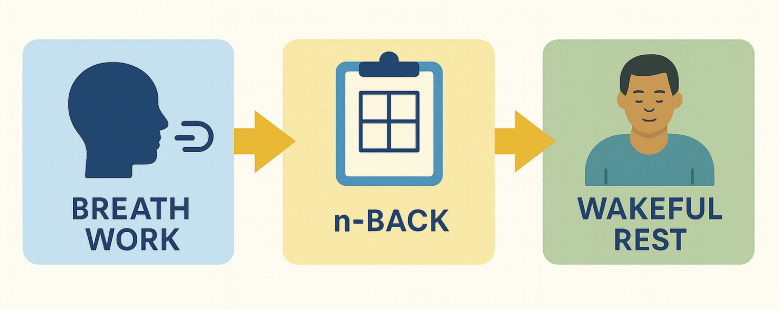Building a Post-Training Quiet Time Into Your Cognitive Training Program
Boost consolidation with Yoga Nidra, Wakeful Rest, or a Nap
My current training program
Training programs come and go over the months. My current training program - a 24 day commitment (around 6 days a week for 4 weeks) - involves this flow:
I am keeping a diary of this training commitment on my IQMindware Substack channel. (Message for details.)
Here I want to highlight options for the post-training component of this training flow.
Post-Training Quiet Time
Ensuring in a brief ‘quiet time’ immediately after any skill-building or cognitive training session harnesses the brain’s neuroplastic consolidation processes — protecting fragile new memory traces from interference and strengthening the very networks you’ve just engaged. Based on a review of the evidence, across a variety of tasks and populations — from children’s word lists to adult motor sequences to TBI rehabilitation — three effective interventin options have emerged. wakeful rest, yoga nidra (meditation), and having a nap).
Let’s take a closer look at each of these in turn.
1. Wakeful Rest (10–20 min)
Just chilling - or doing routine, effortless activities with minimum cogntive demand:
Study Example: Dewar et al. and others show that ∼10 min of post-encoding rest yields better recall of words or images compared to distractors like picture-naming or visual search .
Mechanisms:
Pure Interference Block: Stops new episodic encoding so synaptic tagging (see below) and spontaneous ‘offline’ neural network replay can strengthen fresh traces.
2. Yoga Nidra Meditation (5-20 min)
A guided, eyes-closed, supine practice that systematically directs attention through the body, breath, and visualisation. Here is a Yoga Nidra guided meditation but there are many online - you could find a 10 minute one.
Study Example: Immink et al. found that a single 30 min Yoga Nidra session, three hours post-training, fully stabilised motor sequence memory — performance at test matched end-of-training levels, whereas a light-work control did not.
Mechanisms:
Interference Suppression: Minimal new input lets synaptic tags remain reserved.
Neuromodulation: Increases striatal dopamine (boosting plasticity) and frontal-midline theta (synchronising memory circuits for information transfer). Theta-gated hippocampal replay reinforces practiced patterns.
3. Nap / Sleep (45–90 min)
A brief nap or full night’s sleep following training.
Study Example in TBI: Lequerica and colleagues randomised brain-injured patients to a 45 min nap vs. wake. The nap group showed significant motor gains and reduced fMRI activation in anterior cingulate & cerebellum — signs of automatisation .
Evidence in Healthy Adults: A 70 min nap boosts juggling performance immediately and again after overnight sleep, demonstrating cumulative sleep-dependent gains.
Mechanisms:
Sleep Spindles & Slow Waves: Coordinate hippocampo-cortical dialogue, transferring fragile traces into neocortex for long-term storage.
Hippocampal-Prefrontal Systems Consolidation: Moves motor memory traces from hippocampus toward motor cortex for effortless retrieval.
Your Own Training
By building any of these post-training components into your program, you:
Protect newly encoded traces from interference (all three).
Stabilise synaptic tags and replay practiced patterns (all three).
Promote deeper neuromodulatory and oscillatory processes (Yoga Nidra & nap) that lock in and automatise your learning.
Pick one based on time and context to harness every phase of consolidation and supercharge your next session.
Visual Summary
The Cognitive Neuroscience for Geeks
Mechanisms Involved
How Synaptic Tagging Works
A synapse is the specialized junction where an electrical or chemical signal is transmitted from one neuron’s axon terminal to another neuron’s dendrite or cell body.
Here is the tagging mechanism underlying memory consolidation:
Tag formation: Intense synaptic activation (e.g., practice) induces a molecular tag at that synapse.
PRP capture: Newly synthesized plasticity-related proteins for memory traces diffuse throughout the dendrite but are captured only by tagged synapses.
Outcome: Tagged & PRP-capturing synapses transition from transient potentiation (neural activity) to stable memory consolidation processes (Long Term Potentiation in the hippocampus). Untagged synapses revert to baseline.
By minimising competing synaptic activity — through wakeful rest or brief meditation — you protect these tags from being “overwritten,” giving them the time needed to capture PRPs and cement your learning.
Key References
Wakeful Rest
Dewar, M., Alber, J., Butler, C., Cowan, T., & Della Sala, S. (2012). Brief wakeful rest boosts new memories over the long term. Psychological Science, 23(9), 955–960. https://doi.org/10.1177/0956797612441220
Craig, M. A., Dewar, M., Wojtowicz, A., & Anderson, M. C. (2014). Restful wakefulness aids the maintenance of newly encoded memories. Journal of Experimental Psychology: General, 143(6), 2249–2263. https://doi.org/10.1037/xge0000013
Yoga Nidra
Immink, M. A., Wright, D. L., & Whitford, T. J. (2016). Post-training meditation promotes motor memory consolidation. Frontiers in Psychology, 7, 1689. https://doi.org/10.3389/fpsyg.2016.01698
Parker, K. C., Nielsen, T., & Ramsøy, T. Z. (2017). The neurophysiology of Yoga Nidra: A review of experimental findings. International Journal of Yoga Therapy, 27(1), 55–63. https://doi.org/10.17761/2017-00016
Nap / Sleep
Nishida, M., & Walker, M. P. (2007). Daytime naps, motor memory consolidation and regionally specific brain activation. NeuroImage, 35(1), 123–131. https://doi.org/10.1016/j.neuroimage.2006.11.032
Mednick, S. C., Nakayama, K., & Stickgold, R. (2003). Sleep-dependent learning: A nap is as good as a night. Nature Neuroscience, 6(7), 697–698. https://doi.org/10.1038/nn1078
Synaptic Tagging
Rogerson, T., Cai, D., Frank, A. et al. (2014). Synaptic tagging during memory allocation. Nat Rev Neurosci 15, 157–169. https://doi.org/10.1038/nrn3667







